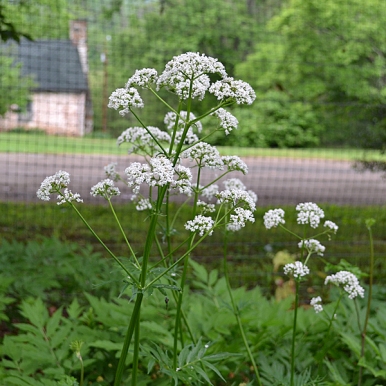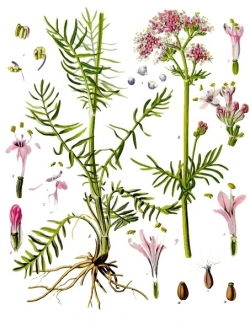General Information:
- Range: Europe and Northern Asia (naturalized in Eastern North America)
- Common name: Valerian
- Duration: Perennial
- Habitat: Herb
- Valerian is known to grow in damp areas, and they are easily spotted by their tall, sturdy stems, dark green leaves, and masses of lightly colored flowers
- It produces a strong and often unpleasant odor that is distinctive to Valerian


History and Traditional Uses:
Valerian has been used throughout history as a sedative to help ease insomnia, anxiety, muscle tension, and emotional stress. There are other uses of Valerian, although there is no scientific evidence to support the effectiveness. The first documented medicinal use of Valerian was by Isaac Judaeus in 924 CE. Galen and Dioscorides, Greek physicians, nicknamed the plant “phu” for its strong, unpleasant odor. This plant has been popular throughout history as a mild sedative used for anxiety and sleep disorders; Hippocrates and Galen documented the uses of Valerian. Valerian also has a rich history in Nordic, Persian, and Chinese cultures. Its use is also documented during the First and Second World Wars for treating shell shock and nervous stress. The roots/rhizomes of Valerian are dried and used to create herbal supplements, oils, and teas, although the supplements are the most commonly used. It is used most commonly to treat sleep insomnia, anxiety, muscle cramps and tensions, digestive troubles, and overactive hearts; however, it has recently been used for treating symptoms of ADHD and menopause.


Shown below are images of the leaves, flowers, and roots. The roots are the part of the plant used for medicinal purposes.
Chemical Constituents:
There are many chemical constituents (about 150) that are present in Valerian, including many organic acids, alkaloids, terpenes, valepotriates, and favones. Valeric and valerenic acid are volatile oils that are responsible for the plant’s strong odor.
Current Research:
The effectiveness and mechanism of Valerian is being researched in many areas including Parkinson’s Disease, sleep/insomnia, hyperactivity and concentration, mental health, and women’s health. The most research can be found in the category of women’s health, including research on the effect of Valerian on premenstrual syndrome symptoms, hot flashes during menopause, and sleep disorders during menopause. Valerian was found to alleviate the side effects of hot flashes (click here for full article). It was also found to reduce symptoms of sleep disorders in women during menopause when taken with lemon balm (click here for full article). Another study found that valerian root extract may reduce the symptoms of PMS (click here for full article). Other current research articles are linked below:
Hyperactivity, concentration difficulties, and impulsiveness
Other Sources:
http://www.sciencedirect.com/science/article/pii/S1214021X14600028
https://ods.od.nih.gov/factsheets/Valerian-HealthProfessional/
http://naturaldatabase.therapeuticresearch.com/(X(1)S(rmpbqmvksndtsk55oj1i5sea))/nd/Search.aspx?cs=CE_NODEACT&s=ND&pt=100&id=870&fs=ND&searchid=60318481
http://www.botanical.com/botanical/mgmh/v/valeri01.html
http://www.anniesremedy.com/herb_detail117.php
http://umm.edu/health/medical/altmed/herb/valerian
Page created by Rachel Klaras
